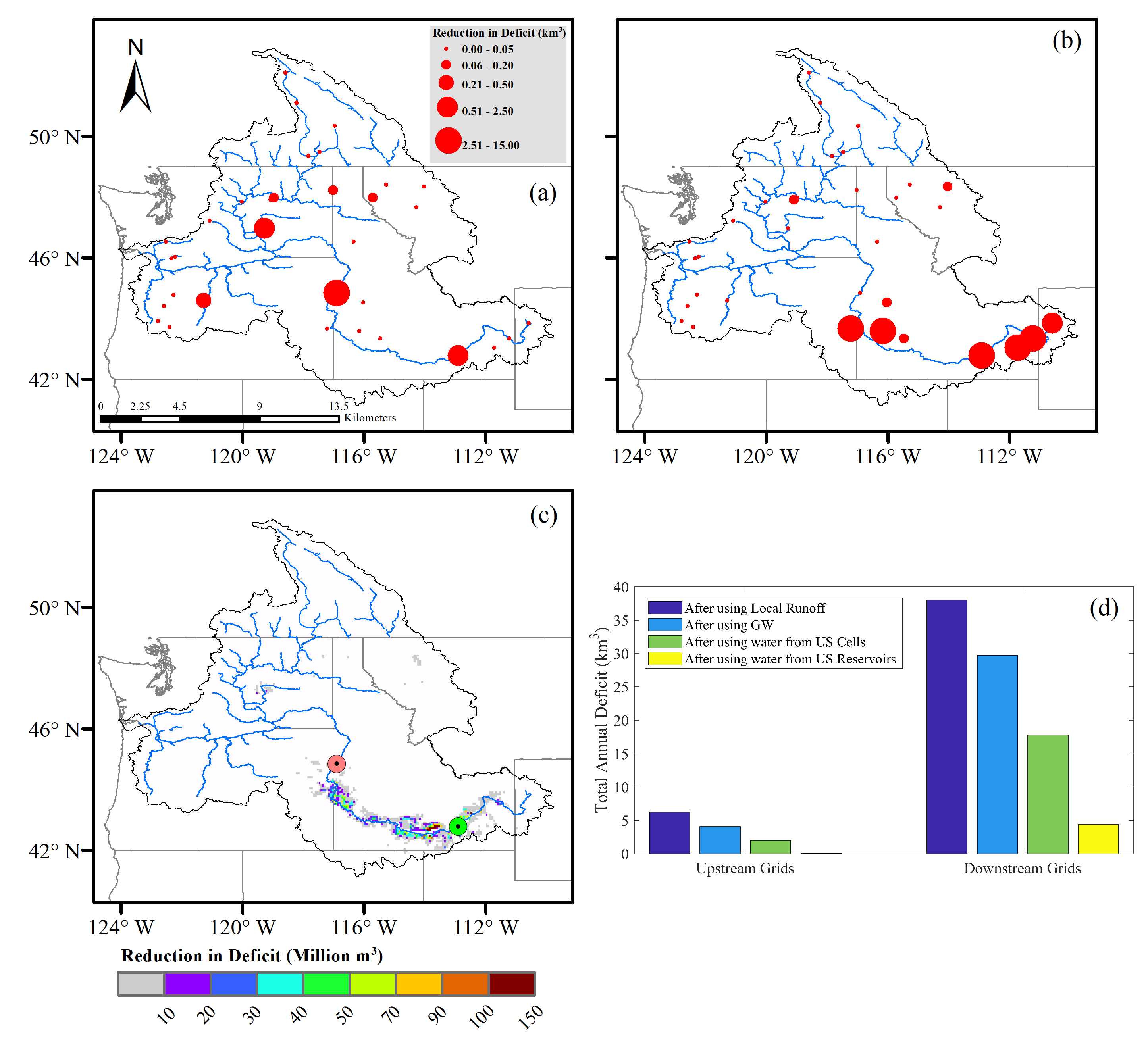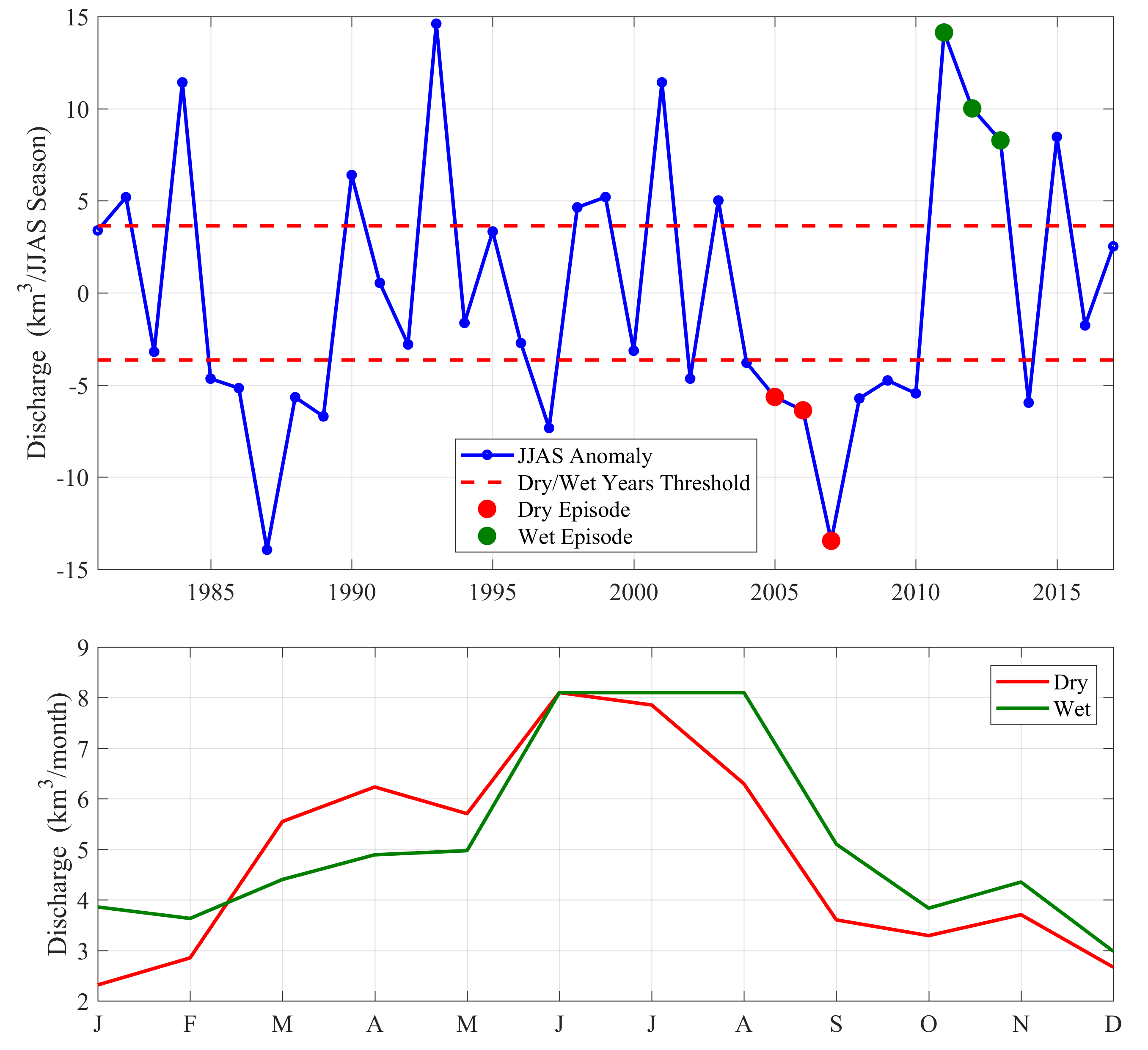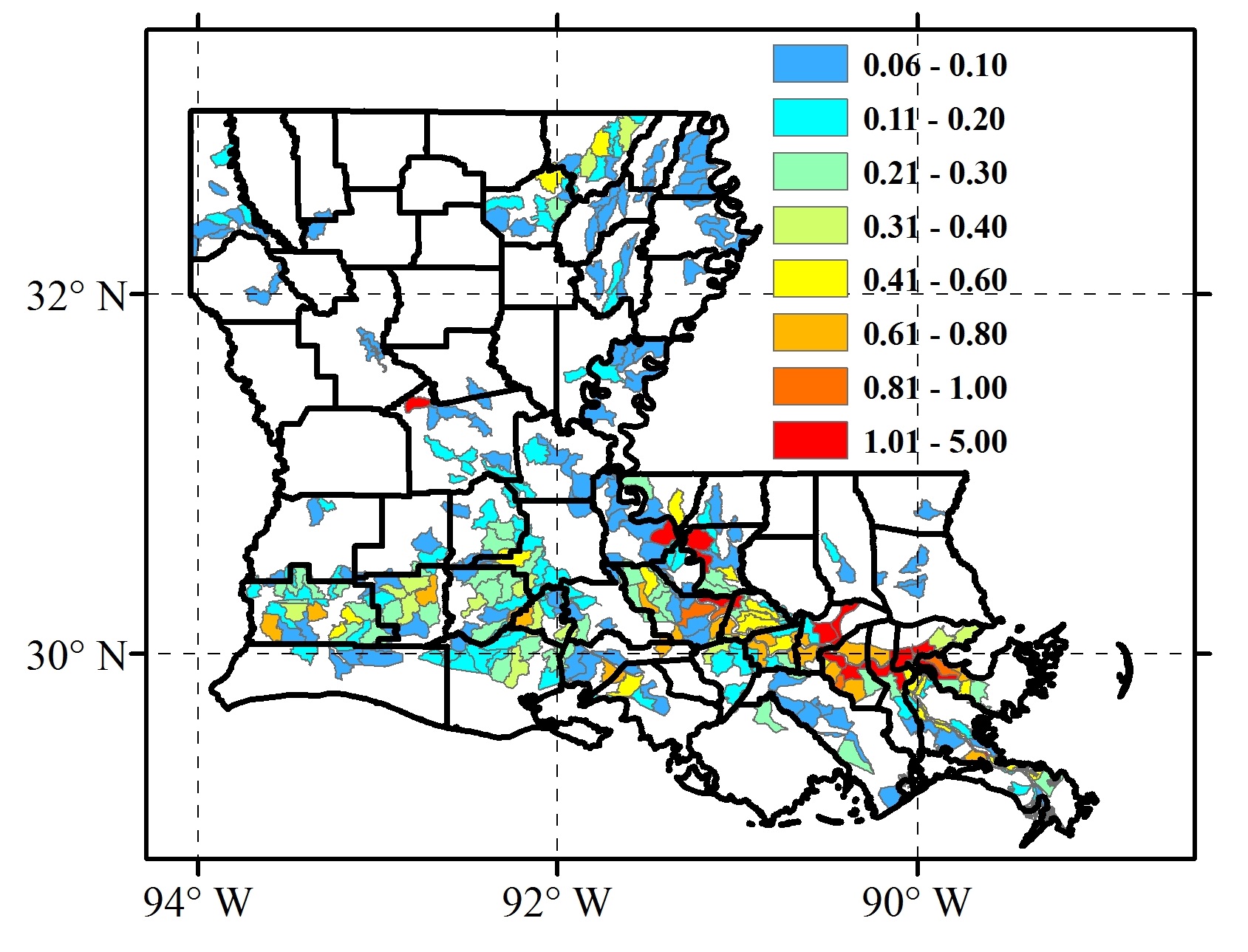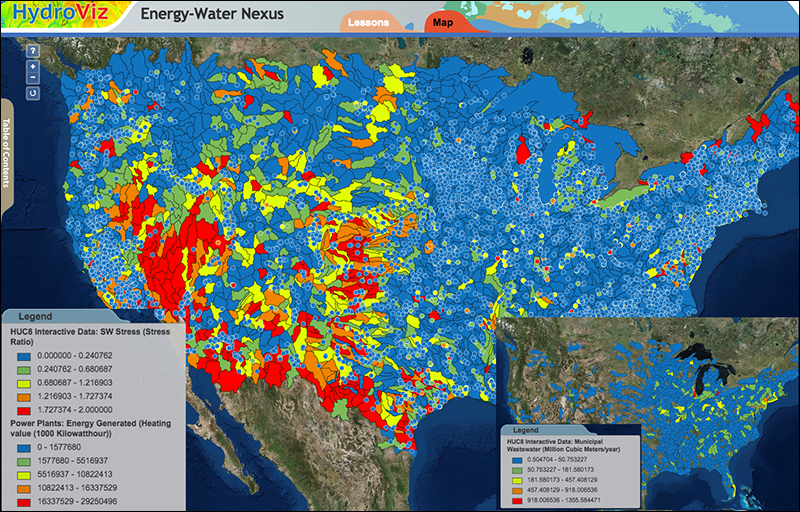Integrated Modeling
The Role of Groundwater Withdrawals on River Regulated Flow
The primary research question addressed in this study is: How does groundwater pumping modulate the regulated streamflow in the CRB? The sensitivity of groundwater withdrawals to streamflow was performed using a modified version of the Variable Infiltration Capacity (VIC) model integrated with a water management component (VIC-IRR). The VIC-IRR version integrates a standardized method of irrigation with a reservoir module for dam release optimizations. Yet, the VIC-IRR version omits the consideration of groundwater availability when allocating the water needed for irrigation, which can have significant impacts on streamflow variability. We further augmented the VIC-IRR to include a third water management scheme that accounts for groundwater withdrawals and therefore allows for more supply options to irrigation demands (namely, VIC-GIRR version).

Reduction in total annual deficits after considering groundwater pumping (km3) at grid cells located upstream (a) and downstream (b) of each reservoir. (c) Reduction in total annual deficit (million m3) over the CRB. d) Total annual deficit in the grids located upstream and downstream of the American Falls Dam located at the upper Snake River. The deficit is calculated for VIC-GIRR 1234 scenario (GW has a priority of 2).
Highlights
• Higher dam releases and storage fraction are simulated when groundwater withdrawals are considered.
• In dry years, deficits in surface water supply are offset by groundwater withdrawals.
• Future research directions include accounting for non-irrigation sectoral water withdrawals and impacts of climate change scenarios.
Scientific Focus Area (SFA): Integrated Modeling - Water System Dynamics
Reference:
Eldardiry, H., Zhou, T., Huang, M., & Chegwidden, O. (2022). The Role of Groundwater Withdrawals on River Regulation:
Example from the Columbia River Basin. Water Resources Research
Satellite-based Framework for Modeling Reservoir Operation
This study presents the water management value of a modeling framework to predict the current and future reservoir operating rules
in lower Nile basin using satellite earth observations and hydrologic models.
The platform comprises the Variable Infiltration Capacity (VIC) hydrologic model driven by high spatial and temporal resolution of satellite observations.
Reservoir storage change is estimated using altimeter and visible imagery of lake area for Lake Nasser and then applied
to infer reservoir operation for High Aswan Dam (HAD).

Upper Panel: The discharge anomalies at Eldiem station (location of GERD dam in Ethiopia) averaged over the rainy season JJAS (June-July-August-September) during the period (1981–2017). Lower Panel: Operating curve of HAD for wet vs drought episodes using the satellite-based framework
Highlights
• The hydrological modeling of the BNB shows high accuracy in simulating streamflow along the Blue Nile Basin (validated at Khartoum and Eldiem stations).
• Monthly HAD releases using satellite altimeter show good agreement with measured discharge downstream of the dam.
Scientific Focus Area (SFA): Integrated Modeling - Remote Sensing
Reference: Eldardiry, H., & Hossain, F. (2019). Understanding Reservoir Operating Rules in the Transboundary Nile River Basin Using Macroscale Hydrologic Modeling with Satellite Measurements. Journal of Hydrometeorology, 20(11), 2253-2269 (DOI: https://doi.org/10.1175/JHM-D-19-0058.1).
Adapting High Aswan Dam Operation to Challenges of the Grand Ethiopian Renaissance Dam
The resilience of HAD operation to GERD construction typifies one of the challenges facing dam operators and water managers in downstream Nile riparian countries.
Recently, various studies have investigated the impacts of GERD on downstream countries with more focus on the GERD filling strategies.
However, crucial insights on how dam operators can adapt to potential impacts have not been capitalized in previous studies.
Our study proposes a physical blueprint that employs water scarcity indices to infer modified reservoir operation
that could adapt to streamflow alterations while maintaining the supply to downstream water use, i.e., water supply for irrigation and hydropower demands.

Schematic diagram of the blueprint proposed to re-evaluate the operation of existing dam under the filling/operation of an upstream planned dam.
Highlights
• High Aswan Dam can adapt its operation in summer months by elevating the downstream stress level (store more and release less),
to mitigate the effects of rapid GERD filling.
• A 7-year filling scenario by Ethiopia is minimally disruptive to operations of High Aswan Dam and results in faster recovery.
Scientific Focus Area (SFA): Integrated Modeling - Remote Sensing - Infrastructure Resilience
Reference:
Eldardiry, H., & Hossain, F. (2020). A Blueprint for Adapting High Aswan Dam Operation in Egypt to Challenges of Filling
and Operation of the Grand Ethiopian Renaissance Dam. Journal of Hydrology (DOI: https://doi.org/10.1016/j.jhydrol.2020.125708).
The Value of Long-term Streamflow Forecasts in Adaptive Reservoir Operation
Our study evaluates the use of long-term climate forecasts
to improve real-time operations of High Aswan Dam (HAD) in the Nile river basin.
A suite of eight models from North American Multimodel Ensemble (NMME) are used to generate monthly precipitation
and temperature forecasts at up to 12 months of lead time. The NMME forcing are used to drive the Variable Infiltration Capacity (VIC) model
and produce monthly streamflow forecasts for an optimization horizon of four years from 1998 to 2001.
The value of NMME-based forecasts to reservoir operations are compared with perfect and climatology-based forecasts.

Forecast-based Adaptive Reservoir Operation (FARO) framework for deriving adaptive reservoir operating policy using streamflow forecasts
Highlights
• The forecast horizon for HAD operation ranges between 8- and 11-month lead time at low and high demand scenarios, respectively, beyond which the forecast information no longer improves the release decision.
• Actual forecasts from NMME models can significantly improve the HAD operation with an average gain in forecast value of 77%
compared to the climatology-based forecasts.
• When considering the operation of upstream Grand Ethiopian Renaissance Dam (GERD), using streamflow forecasts minimally helps to maintain current target objectives of HAD operation and therefore result in higher operation costs as opposed to current conditions without GERD.
Scientific Focus Area (SFA): Integrated Modeling - Infrastructure Resilience
Reference: Eldardiry, H., & Hossain, F. (2021). The Value of Long-term Streamflow Forecasts in Adaptive Reservoir Operation: The Case of High Aswan Dam in the Transboundary Nile River Basin. Journal of Hydrometeorology.
Small-Scale Catchment Analysis of Water Stress in Wet Regions of the U.S.
Using the state of Louisiana as an example, this study quantifies the stresses on water resources and investigates the potential for opportunities to use surface water in lieu of groundwater pumping. The assessment is based on a fine watershed scale (12-digit Hydrological Unit Code [HUC] boundaries) water balance between the availability of surface and groundwater and surface water and groundwater demand. Water demand includes environmental flows, as well as public supply, rural domestic, industrial, power generation, agricultural, and aquaculture sectors. The seasonality of water stress is also addressed by incorporating monthly variations in surface water supply and irrigation demands.

Water Supply Stress Index (WaSSI) on the HUC12 scale derived using annual average estimates of water supply and demand and a 50% environmental flow requirement (HUC12 watersheds with WaSSI less than 0.06 are displayed in white).
Highlights
• The areas of the highest water stress in Louisiana are largely attributable to water consumption for power generating plants or irrigation.
• The stress analysis reveals a significant over-drafting/deficit of groundwater in many of the states aquifer systems.
• Seasonal fluctuations in surface water supply and water withdrawals for irrigation highlight the fact
that the water system is under more stress during the summer season.
Scientific Focus Area (SFA): Integrated Modeling - Water System Dynamics
Reference:
Eldardiry, H., Habib, E., & Borrok, D. M. (2016). Small-scale catchment analysis of water stress in wet regions of the US: an example from Louisiana.
Environmental Research Letters, 11(12), 124031.
(DOI: https://doi.org/10.1088/1748-9326/aa51dc).
Energy-Water Nexus over the CONUS
The interactions between food production, energy production, and water supplies, sometimes referred to as the food-energy-water (FEW) nexus, are critically important to sustaining society. Two components of this nexus, energy and water, are strongly interrelated: Generating electricity and refining fuel require us to use water; pumping, delivering, and treating water require us to use energy. Links between the energy and water systems are expected to intensify in the future. Therefore, it is important to understand and foster continued attention to the interdependency between the systems in the water-energy nexus.

Using the energy-water nexus (HydroViz platform) to estimate net availability of water-for-energy resources and stresses on the water system (main panel) under different future scenarios of population growth, plant retrofitting options, and potential use of non-potable water resources (small inset).
Highlights
• Increase in energy demand may infringe on water availability for other sectors, and it is important to explore if non-potable water resources can alleviate such infringement.
• Changing the plant cooling system (e.g., re-circulating, versus once-through), fuel type (e.g., coal, natural gas),
or limiting greenhouse gas emission (e.g., via a carbon capture and sequestration, CCS) are primary factors to consider when assessing stresses on water system.
Scientific Focus Area (SFA): Integrated Modeling - Water Energy Dynamics
Reference:
Habib, E., Eldardiry, H., and Tidwell, V. (2017). New online tool teaches students about the energy-water nexus, Eos, 98.
(DOI: https://doi.org/10.1029/2017EO084487).